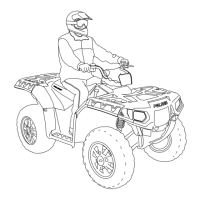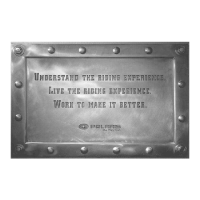12.25
ELECTRICAL
12
STARTER MOTOR
Starter / Starter Lockout System Diagram
The starter and starter lockout system consists of:
• Battery / Fuse or Circuit Breaker
• Key Switch / Off/Run Switch
• Starter Solenoid
• Brake Switch / Transmission (Neutral) Switch
• Start Diode
•Starter Motor
Troubleshooting
Starter Motor Does Not Run
• Battery discharged
• Loose or faulty battery cables or corroded connections
(see Voltage Drop Tests)
• Related wiring loose, disconnected, or corroded
• Poor ground connections at battery cable, starter motor
or starter solenoid (see Voltage Drop Tests)
• Faulty key switch or Off/Run Switch
• Faulty transmission switch
• Faulty Start Diode(s). Use a digital multi-meter to test
diode operation. Locate the diode(s) in the main
harness under the hi-temp conduit and measure between
the diode connections. Continuity should flow one
direction only.
• Faulty starter solenoid or starter motor
• Engine problem - seized or binding (can engine be
rotated easily)
Starter Motor Turns Over Slowly
• Battery discharged
• Excessive circuit resistance - poor connections (see
Voltage Drop Test)
• Engine problem - seized or binding (can engine be
rotated easily)
• Faulty or worn brushes in starter motor
Starter Motor Turns - Engine Does Not Rotate
• Faulty starter drive
• Faulty starter drive gears or starter motor gear
• Faulty flywheel gear or loose flywheel
Voltage Drop Testing
The Voltage Drop Test is used to test for bad connections. When
performing the test, you are testing the amount of voltage drop
through the connection. A poor or corroded connection will
appear as a high voltage reading. Voltage shown on the meter
when testing connections should not exceed 0.1 VDC per
connection or component.
To perform the test, place the meter on DC volts and place the
meter leads across the connection to be tested. Refer to the chart
on 9.35 to perform voltage drop tests on the starter system.
Voltage should not exceed 0.1 Vdc
per connection.
PartShark.com
877-999-5686

